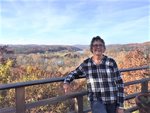

Journalists like me often get to see things or do things not generally available to the public — happier things I will always treasure and tragic ones I wish I could erase from my memory.
So, when Linda Sauter invited me to check out the view from her Upper Black Eddy home atop the imposing Delaware Palisades, I jumped at the opportunity to pick up another happy memory.
Linda had read my columns about a work camp a group of World War 1 veterans had set up along the tall cliffs in 1932. The camp was not on her property, she said, but she suspects a nearby apple orchard supposedly planted by the men may have been the one mentioned in my column.
She met me at her gated driveway, which is almost a mile long. We walked through her house to her large deck only to find a view so magical it made me gasp. The cliff-edge property is situated directly above the intersection of routes 611 and 32, just outside the village of Kintnersville in Nockamixon Township. The cliffs run about three miles along the river from Kintnersville to Narrowsville.
Geologists say the cliffs were formed between 200 and 250 million years ago when molten magma from the earth’s crust turned red sandstone and shale into a harder rock.
Linda sees their beauty in all seasons – in the pastel hints of spring, the varied greens of summer, the blaze of golds and deep reds of fall and the stark icy blasts of winter.
The day I visited was on and off sunshine and the pewter clouds just added to the dramatic beauty of the hills lining both sides of the river and stretching mile after mile into New Jersey.
The autumn foliage hid most of the Delaware flowing far below, but a bit of the river could be seen as the sun sparkled off the water.
“Is that Trauger’s farm down there?” I asked Linda when I saw the plowed fields and buildings I recognized. “Yes,” she said, “we are blessed to have a view of that and the old quarry and the river.” She said she could see when different crops were planted and harvested and once even watched as floodwaters overtook the fields.
Linda and her husband, Dave, have shared their home and its breathtaking view for more than 40 years. “This is right on the point,” Dave said. “We’re the only people to have a 180-degree view of the river.” Others who live along the river get only a slice of the scenery, he explained.
Their home is on a one-acre parcel of land that was once part of 100-plus acres farmed by Woodrow Rufe. A few other homes are scattered on the original farm.
The Sauters’ home was actually little more than a cabin when they bought it, Linda said. Dave has been in construction all his life and over the years the couple improved the house, turning it into a comfortable home with windows all around, bringing the view of the river inside and totally connecting with the natural world.
Lynn Island, far below, is the home of eagles. Naturalists say the handsome birds have been making a comeback after near extinction in the region. “At first we would see an eagle or two,” Linda said. “Now they fly past all the time. Now, in the fall, we can watch their courtship displays where they fly in circles. The chicks will be born in January.”
Linda said their property was once owned by Herbert C. Lanks (1899-1987), an author and photographer, who wrote a series of popular global travel books as well as a book about covered bridges.
“Our house was built in 1950 and was his summer cottage,” she said.
“He had big square dancing parties on what were then terraced hills in the ravine. He had someone drive him past the house once and I am so sorry I didn’t get more information from him. When we moved in in 1981 all that was left were lights strung up and down the side of the cliff.”
A magical place? Undeniable.
Join our readers whose generous donations are making it possible for you to read our news coverage. Help keep local journalism alive and our community strong. Donate today.